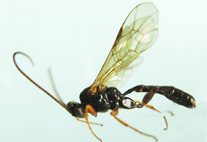Abstract
Oribatid mite communities were studied in the Central Alps(Obergurgl, Tyrol, Austria). Samples were taken on four sites along an altitudinal gradient from 2050 m a.s.l to 2900 m a.s.l., in different vegetation units (pine forest, Nardetum, Caricetum, Androsacetum). A total of 86 species were found, most of them occurred only at one altitude, four species were found in all four study sites. Three taxa could not be ascribed to a certain species (Carabodes sp. Mycobates sp., Tectocepheus sp.). Species richness and density of oribatid mites decrease with increasing altitude. The results are compared with previous studies in the same region and show remarkable shifts in species composition.
References
Bayartogtokh, B. & Schatz, H. (2008) Trichoribates and Jugatala (Acari: Oribatida: Ceratozetidae) from the Central and Southern Alps, with notes on their distribution. Zootaxa, 1948, 1–35.
Fischer, B.M. & Schatz, H. (2007) Hornmilben (Acari: Oribatida). In: Kranebitter P. & Wilhalm T. (Eds.), GEO-Tag der Artenvielfalt 2007 am Fuß des Plattkofels (Seiser Alm, Gemeinde Kastelruth, Südtirol, Italien), Gredleriana, 7, 435–438.
Fischer, B.M. & Schatz, H. (2009) Hornmilben (Oribatida). In: Wilhalm T. (Ed.), GEO-Tag der Artenvielfalt 2008 am Reschenpass (Gemeinde Graun im Vinschgau, Südtirol, Italien). Gredleriana 9, 310–315.
Halbert, J.N. (1915) Acarinida II. Terrestrial and Marine Acarina. Clare Island Survey, part. 39. Proceedings of the Royal Irish Academy, 31(2), 45–136.
Handschin, E. (1924) Die Collembolenfauna des Schweizerischen Nationalparks. Denkschriften der Schweizerischen Naturforschenden Gesellschaft 60, 89–174.
Kaufmann, R., Fuchs, M. & Gosterxeier, N. (2002) The soil fauna of an alpine glacier foreland: colonization and succession. Arctic Antarctic and Alpine Research, 34, 242–250.
http://dx.doi.org/10.2307/1552481Koch, E.M., Erschbamer, B. (2010) Glaziale und periglaziale Lebensräume im Raum Obergurgl. Innsbruck university press, Innsbruck, 304 pp.
Laumann, M., Norton, R.A., Weigmann, G., Scheu, S., Maraun, M. & Heethoff, M. (2007) Speciation in the parthenogenetic oribatid mite genus Tectocepheus (Acari, Oribatida) as indicated by molecular phylogeny. Pedobiologia, 51, 111–122.
Mahunka, S. & Mahunka-Papp, L. (2000) Oribatids from Switzerland III (Acari, Oribatida, Oppiidae 1 and Quadroppiidae) (Acarologica Genavensia XCIII). Revue Suisse de Zoologie, 107, 49–79.
Maraun, M. & Scheu, S. (2000) The structure of oribatid mite communities (Acari, Oribatida): patterns, mechanisms and implifications for future research. Ecography 30 (3), 374–383.
Moritz, M. (1976) Revision der europäischen Gattungen und Arten der Familie Brachychthoniidae (Acari, Oribatei). Teil 1. Allgemeiner Teil: Brachychthoniidae Thor, 1934. Spezieller Teil: Liochthonius v.d. Hammen, 1959, Verachthonius nov.gen. und Paraliochthonius nov.gen. Mitteilungen aus dem Zoologischen Museum in Berlin, 52, 227–319.
http://dx.doi.org/10.1002/mmnz.19760520104Nübel-Reidelbach, E. (1994) Taxonomie und Systematik der Gattung Tectocepheus Berlese, 1895 (Acari, Oribatei). Andrias, Karlsruhe,12, 3–94.
Reeves, R.M. & Behan-Pelletier, V. (1998) The genus Carabodes (Acari: Oribatida: Carabodidae) of North America, with descriptions of new western species. Canadian Journal of Zoology, 76(10), 1898–1921.
Schatz, H. (1978) Oribatiden-Gemeinschaften (Acari: Oribatei) oberhalb der Waldgrenze im Raum Obergurgl (Tirol, Österreich). Berichte des naturwissenschaftlich-medizinischen Vereins in Innsbruck, 65, 55–72.
Schatz, H. (1979) Ökologische Untersuchungen an Wirbellosen des zentralalpinen Hochgebirges (Obergurgl, Tirol). II. Phänologie und Zönotik von Oribatiden (Acari). Veröffentlichungen der Universität Innsbruck, 117, 15–120.
Schatz, H. (1983) U.-Ordn.: Oribatei, Hornmilben. Catalogus Faunae Austriae, Wien, Teil IXi: 118 pp.
Schatz, H. (2004) Die Hornmilbenfamilie Brachychthoniidae (Acari, Oribatida) in Tirol (Österreich). Denisia, 12, 343–355.
Schatz, H. (2008) The Schlern/Sciliar Massif (Southern Alps, Italy) – a biodiversity hotspot for oribatid mites (Acari, Oribatida). In: Bertrand, M., Kreiter, S., McCoy, K.D., Migeon, A., Navajas, M., Tixier, M.S. & Vial, L. (Eds.): Integrative Acarology. Proceedings of the 6th European Congress, European Association of Acarologists, Montpellier, France, pp. 24–31.
Schatz, H. & Fischer, B.M. (2011) Hornmilben (Acari, Oribatida). GEO-Tag der Artenvielfalt 2010 im Pfelderer Tal (Passeier, Gemeinde Moos i.P., Südtirol, Italien). Gredleriana, 11, 189–194.
Schatz, H. & Fischer, B.M. (2013) Die Hornmilben (Acari: Oribatida) der Jagdberggemeinden. In: Naturmonografie Jagdberggemeinden. Inatura Erlebnis Naturschau, Vorarlberg, pp. 569–580.
Schatz, H. & Schuster, R. (2009) Acari – Oribatida, Hornmilben. In: Rabitsch, W. & Essl, F. (Eds.), Endemiten in Österreich. Kostbarkeiten in Österreichs Tier- und Pflanzenwelt. Naturwissenschaftlicher Verein für Kärnten, Klagenfurt und Umweltbundesamt GmbH, Klagenfurt / Wien, pp. 464–475.
Schmölzer, K. (1993) Die hochalpinen Landmilben der östlichen Brennerberge (Acarina terrestria). Veröffentlichungen des Tiroler Landesmuseums Ferdinandeum Innsbruck, 73, 47–67.
Schwalbe, T. (1989) Oppiella signata, eine neue Art der Familie Oppiidae aus dem Osterzgebirge (Acari, Oribatei). Deutsche Entomologische Zeitschrift, Neue Folge, 36, 99–101.
http://dx.doi.org/10.1002/mmnd.19890360111Schweizer, J. (1922) Beiträge zur Kenntnis der terrestrischen Milbenfauna der Schweiz. Verhandlungen der Naturforschenden Gesellschaft in Basel, 23, 23–112.
Schweizer, J. (1956) Die Landmilben des Schweizerischen Nationalparks. 3. Teil, Sarcoptiformes Reuter 1909. Ergebnisse der wissenschaftlichen Untersuchungen des schweizerischen Nationalparks, 5(34), 213–377.
Shtanchaeva, U.Ya. & Subías, L.S. (2010) Catalogue of oribatid mites of the Caucasus. Dagestan Scientific Center, Russian Academy of Sciences, Makhachkala, 276 pp. (in Russian)
Sørensen, T. (1948) A method of establishing groups of equal amplitude in plant sociology based on similarity of species and its application to analyses of the vegetation on Danish commons. Biologiske Skrifter/ Kongelige Danske Videnskabernes Selskab, 5, 1–34.
Subías, L.S. (2012) Listado sistemático, sinonímico y biogeográfico de los ácaros oribátidos (Acariformes: Oribatida) del mundo (excepto fósiles). (Originally published in Graellsia, 60 (número extraordinario): 3–305 (2004), actualized in April 2012, 564 pp.) available at: www.ucm.es/info/zoo/Artropodos/Catalogo.pdf. [Accessed 14th August, 2012]
http://dx.doi.org/10.3989/graellsia.2004.v60.iExtra.218Weigmann, G. (2002) Morphological variability between and within populations of Tectocepheus (Acari, Oribatida, Tectocepheidae) from the velatus-complex in Central Europe. In: Bernini, F., Nannelli, R., Nuzzaci, G. & De Lillo, E. (Eds): Acarid Phylogeny and Evolution: Adapation in Mites and Ticks. Proceedings of the IV Symposium of the European Association of Acarologists, Siena 2000. Kluwer Academic Publishers, Dordrecht – Boston – London, pp. 141–152.
Weigmann, G. (2006) Hornmilben (Oribatida). Die Tierwelt Deutschlands, 76. Teil. Goecke & Evers, Keltern, 520 pp.
Weigmann, G. & Norton, R.A. (2009) Validity and interpretation of Murcia Koch, Trichoribates Berlese and their type species (Acari: Oribatida: Ceratozetidae). Zootaxa 2107, 65–68.
Woas, S. (1986) Beitrag zur Revision der Oppioidea sensu Balogh, 1972 (Acari, Oribatei). Andrias 5, 21–224.

